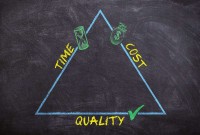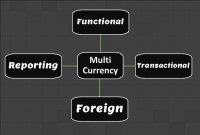- Home
- Business Processes
- Industry Knowledge
- Aerospace Industry
- Automotive Industry
- Banking Domain
- BFSI Industry
- Consumer/ FMCG Industry
- Chemicals Industry
- Engineering & Construction
- Energy Industry
- Education Domain
- Finance Domain
- Hospitality Domain
- Healthcare Industry
- Insurance Domain
- Retail Industry
- Travel and Tourism Domain
- Telecom Industry
- Leadership Skills
- eLearning
- Home
- Functional
- General Ledger (Record to Report)
- GL - GAAP Accounting
GL - GAAP Accounting
Generally Accepted Accounting Principles define the accounting procedures, and understanding them is essential to producing accurate and meaningful records. In this article we emphasize on accounting principles and concepts so that the learner can understand the “why” of accounting which will help you gain an understanding of the full significance of accounting.
Why Generally Accepted Accounting Principles?
If every company’s accountants start recording and reporting financial data as they deem fit, without following some common accounting principles and practices, comparisons among the financial data of the different companies would become very difficult, if not impossible. Thus, financial accountants follow generally accepted accounting principles (GAAP) in preparing reports.
Since the purpose of accounting is to convey meaningful and understandable financial information to their stakeholders, the accounting profession has developed generally accepted accounting principles (GAAP) to respond to the need for standardization. These principles define accounting procedures, and understanding them is essential to producing accurate and meaningful records. Before we can understand the concepts of general ledger, understanding these principles is a prerequisite.
The success of any business, big or small, begins with an understanding of accounting. These reports based on the generally accepted accounting principles, allow investors and other stakeholders to compare one company to another. Accounting principles and concepts are developed from research, accepted accounting practices, and pronouncements of authoritative bodies.
Who Defines GAAP?
The Financial Accounting Standards Board (FASB) is the authoritative body having the primary responsibility for developing accounting principles. The FASB publishes Statements of Financial Accounting Standards as well as Interpretations of these Standards.
Apart from “Financial Accounting Standards Board” (FASB), the American Institute of Certified Public Accountants (AICPA), and the Securities and Exchange Commission (SEC) along with the statutory authoritative bodies of various countries (Example – Institute of Chartered Accountants of India, for India), all have all played an influential role in developing generally accepted accounting principles which span across boundaries of nation and have global acceptability.
Efforts are still going on to emerge globally accepted principles, as we still found variations in principles from countries to countries as well as from businesses to businesses that warrant a need to have different accounting methods.
The “Why” of Accounting:
In this article, we emphasize accounting principles and concepts so that the learner can understand the “why” of accounting which will help you define the “how” while designing automated accounting systems because this “why” will help you will gain an understanding of the full significance of accounting. In the following paragraphs, we discuss the five principles that are generally followed by accountants worldwide and they are the business entity concept, cost concept, the objectivity concept, the going-concern concept, and the monetary value principle. By applying generally accepted accounting principles in accounting practices, accountants make sure that their work is consistent and meaningful to others.
GAAP 1: The Business Entity Principle:
Under the business entity concept, the activities of a business are recorded separately from the activities of the stakeholders. The Business Entity Principle states that a business must be considered a separate entity, and only the transactions carried out by the business may be recorded in the accounting books. This ensures that the financial picture of the business represents the activities and events of the business; this reflects the economic impact and value of the business not of its stakeholders. The individual business unit is the business entity for which economic data are needed and must be identified so that the accountant can determine which economic data should be analyzed, recorded, and summarized in reports.
The business entity concept is important because it limits the economic data in the accounting system to data related directly to the activities of the business. In other words, the business is viewed as an entity separate from its owners, creditors, or other stakeholders.
GAAP 2: The Cost Principle:
The Cost Principle states that anything business purchases is recorded as the amount paid, regardless of its real or perceived value. This accounting principle requires the amounts in the accounts to be the actual cost rather than the current or future value. Accountants can show an amount less than cost due to conservatism in certain circumstances, but accountants are generally prohibited from showing amounts greater than cost. This eliminates guesswork or the possibility of recording inaccurate information.
To help you understand this concept let’s consider a real estate transaction. The business has acquired a building for $100,000 by paying the seller in cash after taking a loan from the bank. The Ask Price by the seller was $150,000 and the business was only willing to pay $90,000. As far as the valuation of the property by the corporation is concerned it was valued at $120,000 for property tax purposes. The business applied for a loan from the bank and the approved property assessor estimated the market value of the property to be $125,000. Bank only financed $75,000 against that valuation. After the business bought the property it received an offer of $135,000 the next day from a neighboring store for the same building. What should be the amount that should be entered into the business’s accounting records?
As per the cost principle, the cost of the building for the business here is $100,000 and the other amounts have no effect on the accounting records because they did not result in an exchange of the building from the seller to the buyer. The cost concept is the basis for entering the exchange price, or cost, into the accounting records for the business.
GAAP 3: The Objectivity Principle:
Using the cost concept involves two other important accounting concepts—objectivity and the unit of measure. The Objectivity Principle states that accounting operates on objective evidence. All transactions must have proof that they were carried out. The objectivity concept requires that the accounting records and reports be based upon objective evidence.
In an earlier real estate example, while negotiating the deal, both buyer and seller, try to get the best price. Only the final agreed-upon amount, on the basis of which the transfer of title was initiated, is objective enough for accounting purposes. If the amounts at which property was recorded were constantly being revised based on offers, appraisals, and opinions, accounting reports could soon become unstable and unreliable. The only reliable proof that a transaction occurred is found in source documents such as a sales slip or an invoice and in this case the agreement to sell or sales deed.
GAAP 4: The Unit of Measure Principle:
The unit of measure concept requires that economic data be recorded in monetary terms that are dollars or any other currency as applicable. Money is a common unit of measurement for reporting uniform financial data and reports. This principle also involves another linked principle of “Stable Monetary Unit of Measure “that states that the value of the monetary measure (dollar) does not change. This ensures that the unit of measure (dollar) is kept as a stable unit of measure for accounting purposes. It also makes it easier to compare financial statements over time.
GAAP 5: The Going-Concern Principle:
The 'going concern' concept directs accountants to prepare financial statements on the assumption that the business is not about to go broke or be liquidated. So, unless there is significant evidence to the contrary, accountants will base their valuations and their reporting of financial data on the assumption that the business will remain in existence for an indefinite period. An indefinite period means the foreseeable future or long enough for the business to meet its objectives and to fulfill its commitments.
The implication of this principle is that it establishes that a business is a continuing enterprise and that its buildings, land, or equipment cannot be sold without disrupting the business. So unless the buildings, land, or equipment are for sale, as in the case of liquidation, their market value is not recorded. This prevents distortion in the objective value of the business. Different bases of measurement may be appropriate when the entity is NOT expected to continue in operation for the foreseeable future. Where a company is NOT a going concern, the break-up basis is used where all assets and liabilities are stated at Net Realizable Value.
Related Links
You May Also Like
-
In this article, we will explain the general Ledger journal processing flow from entering journals to running the final financial reports. Understand the generic general ledger process flow as it happens in automated ERP systems. The accounting cycle explains the flow of converting raw accounting data to financial information whereas general ledger process flow explains how journals flow in the system.
-
Global Business Services (GBS) Model
Global business services (GBS) is an integrated, scalable, and mature version of the shared services model. Global Business Services Model is a result of shared services maturing and evolving on a global scale. It is represented by the growth and maturity of the Shared services to better service the global corporations they support.
-
An allocation is a process of shifting overhead costs to cost objects, using a rational basis of allotment. Understand what is the meaning of allocation in the accounting context and how defining mass allocations simplifies the process of allocating overheads to various accounting segments. Explore types of allocations and see some practical examples of mass allocations in real business situations.
-
Although technically a general ledger appears to be fairly simple compared to other processes, in large organizations, the general ledger has to provide many functionalities and it becomes considerably large and complex. Modern business organizations are complex, run multiple products and service lines, leveraging a large number of registered legal entities, and have varied reporting needs.
-
McKinsey 7S Framework is most often used as an organizational analysis tool to assess and monitor changes in the internal situation of an organization. The model is based on the theory that, for an organization to perform well, seven elements need to be aligned and mutually reinforcing.
-
Shared Services is the centralization of service offering at one part of an organization or group sharing funding and resourcing. The providing department effectively becomes an internal service provider. The key is the idea of 'sharing' within an organization or group.
-
For any company that has a large number of transactions, putting all the details in the general ledger is not feasible. Hence it needs to be supported by one or more subsidiary ledgers that provide details for accounts in the general ledger. Understand the concept of the subsidiary ledgers and control accounts.
-
As the business grows, the company may want to transition to a branch structure as branches are allowed to conduct a much broader range of activity than representative offices. Branches can buy and sell goods, sign contracts, build things, render services, and generally everything that a regular business can do. A company expands its business by opening up its branch offices in various parts of the country as well as in other countries.
-
Matrix Organizational Structures
In recent times the two types of organization structures which have evolved are the matrix organization and the network organization. Rigid departmentalization is being complemented by the use of teams that cross over traditional departmental lines.
-
Divisional Organizational Structures
The divisional structure or product structure consists of self-contained divisions. A division is a collection of functions which produce a product. It also utilizes a plan to compete and operate as a separate business or profit center. Divisional structure is based on external or internal parameters like product /customer segment/ geographical location etc.
Explore Our Free Training Articles or
Sign Up to Start With Our eLearning Courses

About Us
Learning
© 2023 TechnoFunc, All Rights Reserved










